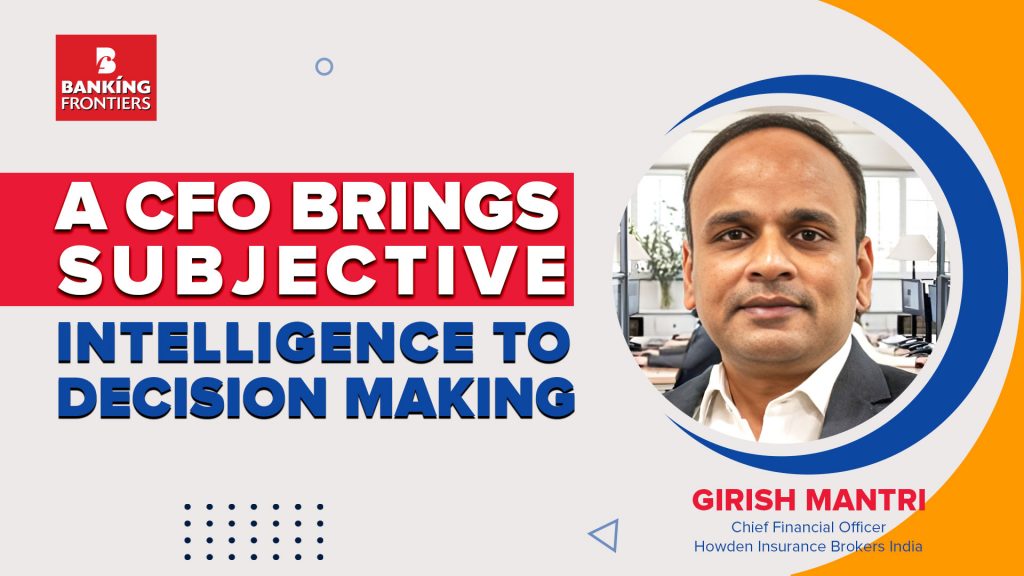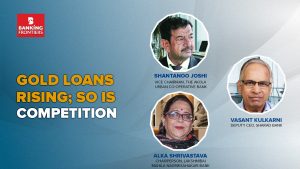Girish Mantri, Chief Financial Officer at Howden Insurance Brokers India shares perspectives on investing in technology, outsourcing, analytics, and decision making:

Ravi Lalwani: Please list the top 3 challenges that CFOs are most likely to face in 2023. What will help them solve each of those challenges – new knowledge, innovation, more IQ, more EQ, or something else?
Girish Mantri: As the pace of adoption of digital technologies accelerates in a post-pandemic world, CFOs will have to be more agile in embracing advanced tools such as data analytics, AI, automation, and cloud solutions to facilitate their organization’s digital transformation. In this context, establishing a culture of simplification, driving standardization by intelligently automating manual processes, and pursuing technology integration initiatives within the outlined budget will be a key challenge.
To achieve sustainable and profitable growth, CFOs will have to transform existing business processes and systems to optimize performance, while addressing ESG concerns and embedding an exclusive strategy within the revitalized business model. We have got new compliances and new laws that keep coming in and we need to ensure 100% compliance with all of those which means that we have just got to be that much more agile with ourselves and with our teams which means we also need to be dynamically developing our teams. Ultimately, the challenge will be to lay the foundations of a future-ready organization by delicately balancing often conflicting aspects in technology decision-making.
In the last couple of years, what has been the major change in your engagement with different CXOs in the company?
The current VUCA environment has not only mandated a deeper collaboration between various teams in an organization, but also between CXOs heading and guiding them through different challenges that spring up during doing business. As a result, it has become important to engage deeply with business teams while designing and implementing business plans, encouraging those involved in managing the company’s finances to work as business partners rather than act as controllers. I drive my team to embody these principles and support the different functions in unlocking value for the organization. In that sense, it would only be apt to position oneself as a custodian of enterprise value, responsible for co-steering profitable business growth through prudent capital allocation.
How should companies update their outsourcing and insourcing approaches considering the dynamic and unpredictable ecosystem today?
While there are many economic benefits of outsourcing tasks in any business, it is crucial to first recognize the company’s core competencies. This involves a thorough internal analysis of each business activity and its contribution to achieving the organization’s mission statement. Focusing on these core competencies or strengths that set an organization apart from its competitors is critical for the long-term survival and success of any business operation. Therefore, these business activities should ideally be insourced, and measures should be taken to foster continuous improvement to further develop the organization’s core competencies.
On the other hand, non-core activities should be explored for outsourcing, especially if external suppliers have a cost advantage in terms of supplying the relevant goods or services. Because such activities constitute a sizeable portion of most organizations’ overall business, it makes sense to prioritize them when creating an outsourcing strategy. Considering the current external business climate, it is important to re-evaluate these aspects periodically and optimize which activities can be outsourced to reduce overall costs of operation.
With rising costs of technology and the varying technology options, what strategic inputs should the CFO community be presenting to the board?
In the current inflationary landscape, CFOs should be increasingly investing in technology to identify opportunities and reduce the cost of doing business. Towards this end, CFOs are expected to have an overall understanding of the latest technology tools, and their digital uses cases and have a cost-benefit analysis for each of them. By leveraging these insights, CFOs can develop a sustainable digital transformation roadmap that balances cost concerns with the potential to capitalize on attractive growth opportunities presented by a digital revolution.
This information can help the company’s board of directors to set the future digital strategy and allocate capital or other resources that may be needed to implement the same. Additionally, with such detailed analysis and planning carried out, the board can act faster in response to the changing technology landscape and prioritize different digital investments accordingly.
With humongous amounts of data available, what kinds of decisions in your domain remain subjective?
 Every financial decision-making process, whether it be regarding new projects or existing ones that need further investments, ought to be made after ascertaining if the capital infusion would add value to the organization and its shareholders. With the increasing use of advanced data analytics tools that can seemingly crunch numbers from a huge data pool, it may seem that such decision-making can be automated completely. However, many assumptions are made when assessing the value that is expected to be generated with every capital investment, thereby introducing a layer of subjectivity that is hard to ignore. This is especially true for the net present value (NPV) rule that is widespread in its use across most organisations in assessing the value that new capital investments are expected to create.
Every financial decision-making process, whether it be regarding new projects or existing ones that need further investments, ought to be made after ascertaining if the capital infusion would add value to the organization and its shareholders. With the increasing use of advanced data analytics tools that can seemingly crunch numbers from a huge data pool, it may seem that such decision-making can be automated completely. However, many assumptions are made when assessing the value that is expected to be generated with every capital investment, thereby introducing a layer of subjectivity that is hard to ignore. This is especially true for the net present value (NPV) rule that is widespread in its use across most organisations in assessing the value that new capital investments are expected to create.
The projection of future cash flows, arriving at the discounting rate for future cashflows, and deducing the NPV of any financial investment can therefore vary depending on the subjectivity introduced by the respective financial manager. This gives me enough reason to believe that, despite the proliferation of technological tools in the financial world, it would be difficult to eliminate the human element in financial modelling.
Read more-








